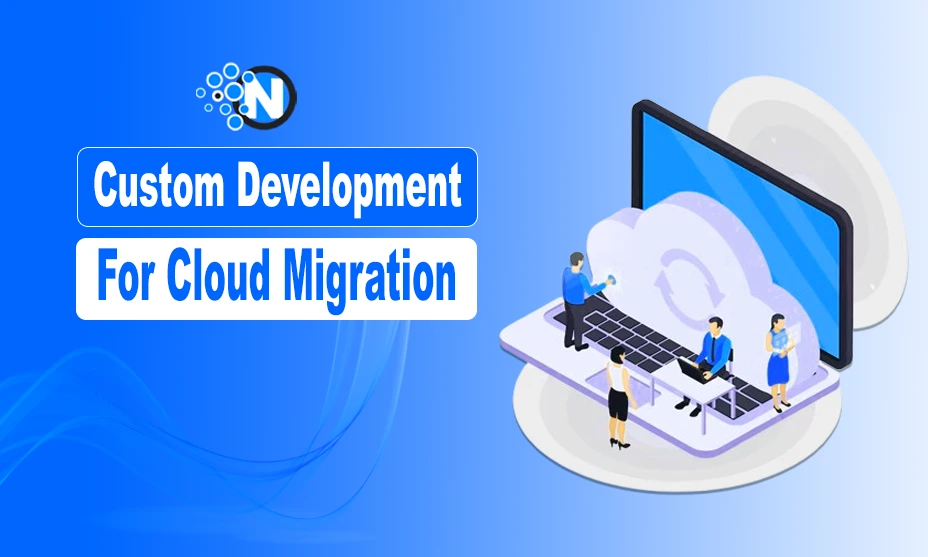Why Custom Development is Essential for Cloud Migration Success

No doubt, legacy is still effective, but the modern age requires modern solutions, like Cloud-based architectures. Although the journey to digitalization isn’t always straightforward while cloud promises scalability, flexibility, and cost-efficiency.
Further, the majority of businesses face problems while migrating towards digitalization as it requires customized software development to refactor, re-architect, and modernize applications.
Although investment can make a big difference… how and why? Let’s discuss the whole plot in the under sections, but first, estimate the challenge!
The Challenge of Migrating Legacy Systems
Legacy applications are typically the result of outdated development practices and monolithic architectures intended for static, on-premises environments. These systems were developed during a time when scalability, flexibility, and continuous delivery were not critical priorities.
While many legacy applications continue to support essential business operations, they’re often ill-suited for the dynamic, distributed nature of modern cloud environments. This is where cloud migration services come to help you do your thing comfortably with expertise.
Rather than simply relocating legacy systems, expert-led cloud migration services assess, re-architect, and modernize applications to align with cloud-native principles.
This might involve replatforming or refactoring code, breaking down monolithic systems into microservices, or introducing containerization and auto-scaling capabilities. These enhancements enable applications to run more efficiently in the cloud, improving resilience, performance, and cost-effectiveness.
Why Custom Software Development is Important?
Instead of settling for a basic “lift and shift” migration strategy, many businesses continue to use custom software development companies to take a more strategic approach. This shift acknowledges that merely moving legacy applications to a cloud environment, without adapting cloud-native features, often falls short of delivering real value.
Working with a custom software development company like Techstack, businesses can undertake code refactoring to clean up outdated logic and enhance maintainability. In complex cases, it may involve re-architecting applications, transitioning from rigid monolithic designs to flexible microservices architectures.
In some scenarios, a complete rebuild from the ground up may be necessary to fully modernize the application and unlock the benefits of speed, scalability, and agility in the cloud.
Refactoring: Cleaning Up Code for the Cloud
Refactoring is the process of systematically improving and restructuring the internal components of existing software code without altering the application’s outward-facing behavior or functionality.
This technique is particularly valuable when preparing legacy applications for deployment in cloud environments. As it helps align the software with modern development standards and cloud-native best practices while preserving its original capabilities. When developers refactor code, they focus on enhancing the internal structure to make it cleaner and easier to work with.
This often includes eliminating unnecessary or outdated code that no longer serves a purpose, which reduces clutter and potential sources of errors. In doing so, the codebase becomes more streamlined and manageable, allowing teams to more easily understand and modify it in the future.
Re-Architecting for Cloud-Native Benefits
In many instances, legacy applications require more than just superficial improvements or code cleanup. They need to be fundamentally reimagined and redesigned to meet the demands of modern cloud environments.
This deeper transformation, often referred to as re-architecting, involves rethinking the entire structure of an application to align with cloud-native principles and technologies.
Through custom software development, businesses can rebuild their applications from the ground up. That’s a way that embraces the scalability, flexibility, and modularity of the cloud into a business.
Custom Development Ensures Business Alignment
Generic migration tools and prepackaged cloud solutions often fall short when it comes to addressing the specific needs of individual organizations.
Every business operates within its own unique framework, defined by internal processes, industry-specific regulations, and the expectations of its customers.
As a result, simply lifting and shifting systems using off-the-shelf tools can lead to compromises in performance. Further, this approach also enhances security, compliance, and overall user experience to outrage the application.
These shortcomings can negatively impact both operational effectiveness and customer trust. Custom software development offers a more tailored and strategic approach to cloud migration by aligning technology with the business’s broader goals.
Rather than trying to retrofit a general solution to meet specialized needs, custom development enables organizations to design systems from the ground up that are purpose-built for their environment.
This ensures that the migration process isn’t only technically successful but also enhances business functionality, user satisfaction, and long-term growth.
Improved Agility and Long-Term ROI
While the initial costs associated with custom software development during a cloud migration may appear high. This investment frequently pays off many times over in the long run.
Unlike quick fixes or generic migration approaches, custom development enables organizations to modernize their applications in ways that directly align with strategic goals and long-term scalability.
Businesses create a more sustainable, agile, and future-proof foundation for innovation by designing software to take full advantage of cloud-native capabilities. Modernized applications built through custom development are not only more efficient, they’re significantly easier to manage, enhance, and scale.
Flexible architectures that follow modern design principles such as microservices and containerization allow developers to roll out updates faster, integrate new tools and APIs more seamlessly, and extend functionality with minimal disruption.
This adaptability ensures that applications can quickly respond to changing market demands, customer expectations. Further, this is also a shift in technology that is helping businesses stay ahead in an increasingly competitive market.
Case in Point: Transforming Legacy into Cloud Advantage
Imagine a manufacturing company that relies on an outdated inventory management system that was originally built two decades ago.
The system, although functional, is no longer suited to the demands of modern business operations and the faster evolving technological market.
Instead of simply rehosting the legacy system on the cloud as-is, the company opts for a more forward-thinking approach: they engage a skilled software development team to refactor key modules and completely re-architect the application for the cloud, specifically AWS.
Final Notes
Migrating from legacy systems to the cloud goes far beyond simply updating technology. This represents a significant strategic opportunity for businesses to modernize their operations and drive innovation.
While many see cloud migration as just a technical task, it is actually a critical turning point for companies to rethink their existing processes, architectures, and capabilities.
This transformation is not just about moving data or applications to a new environment. Although about using the cloud to unlock new possibilities and fuel growth in ways that were not previously possible.




